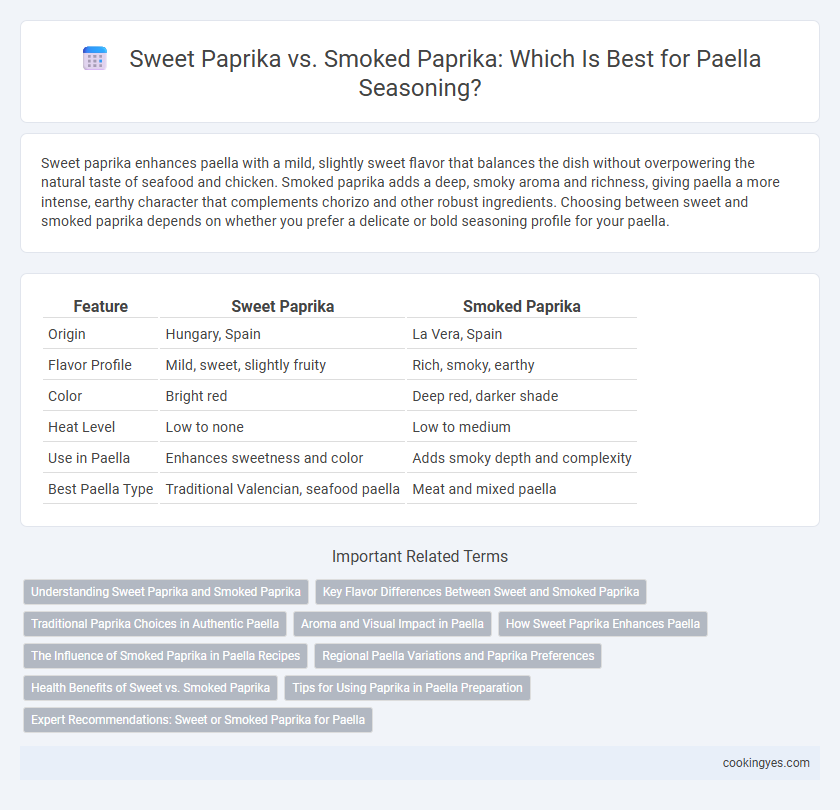Sweet paprika enhances paella with a mild, slightly sweet flavor that balances the dish without overpowering the natural taste of seafood and chicken. Smoked paprika adds a deep, smoky aroma and richness, giving paella a more intense, earthy character that complements chorizo and other robust ingredients. Choosing between sweet and smoked paprika depends on whether you prefer a delicate or bold seasoning profile for your paella.
Table of Comparison
| Feature | Sweet Paprika | Smoked Paprika |
|---|---|---|
| Origin | Hungary, Spain | La Vera, Spain |
| Flavor Profile | Mild, sweet, slightly fruity | Rich, smoky, earthy |
| Color | Bright red | Deep red, darker shade |
| Heat Level | Low to none | Low to medium |
| Use in Paella | Enhances sweetness and color | Adds smoky depth and complexity |
| Best Paella Type | Traditional Valencian, seafood paella | Meat and mixed paella |
Understanding Sweet Paprika and Smoked Paprika
Sweet paprika offers a mild, slightly sweet flavor that enhances the natural taste of saffron and other traditional paella ingredients without overpowering them. Smoked paprika imparts a deep, smoky aroma ideal for adding complexity to meat or seafood paellas, aligning well with the dish's rustic origins in Valencia, Spain. Understanding the distinct profiles of these paprikas helps in selecting the perfect seasoning to balance authenticity and personal taste in paella preparation.
Key Flavor Differences Between Sweet and Smoked Paprika
Sweet paprika provides a mild, slightly sweet flavor that enhances the natural taste of seafood and chicken in paella without overpowering other ingredients. Smoked paprika introduces a deep, smoky aroma and taste derived from drying peppers over wood fires, adding complexity and a subtle earthy note to the dish. Choosing between sweet and smoked paprika depends on whether you prefer a delicate sweetness or a robust smokiness to define your paella's seasoning profile.
Traditional Paprika Choices in Authentic Paella
Traditional paella recipes primarily use sweet paprika, known as pimenton dulce, to impart a mild, slightly sweet flavor that complements the saffron and other spices without overpowering the dish. Smoked paprika, or pimenton ahumado, is less common in authentic Valencian paella but occasionally appears in regional variations, adding a distinct smoky depth that can alter the classic profile. The choice between sweet and smoked paprika significantly impacts the seasoning's balance, with sweet paprika maintaining the traditional essence of paella's flavor complexities.
Aroma and Visual Impact in Paella
Sweet paprika lends a vibrant red hue and a mild, fruity aroma to paella, enhancing the dish's visual appeal without overpowering other flavors. Smoked paprika imparts a deeper, earthy aroma with subtle smokiness, adding complexity and warmth that intensifies the overall sensory experience. Using sweet paprika highlights the dish's bright, traditional appearance, while smoked paprika enriches the aroma and introduces a rustic character to paella.
How Sweet Paprika Enhances Paella
Sweet paprika enhances paella by imparting a mild, subtly sweet flavor that balances the savory seafood and meats traditionally used in the dish. Its vibrant red color enriches the visual appeal of paella, complementing the saffron-infused rice with a warm, inviting hue. Unlike smoked paprika, sweet paprika maintains a delicate, clean taste that preserves paella's authentic, bright Mediterranean profile without overpowering the other ingredients.
The Influence of Smoked Paprika in Paella Recipes
Smoked paprika imparts a rich, smoky depth to paella that enhances the traditional flavors of saffron and seafood, creating a more robust and complex taste profile. Its smoky notes complement the caramelized sofrito base and add warmth to the rice, distinguishing authentic Valencian-style paellas from those seasoned with sweet paprika. Using smoked paprika elevates the dish by intensifying the savory and earthy elements, making it essential for achieving a true depth of flavor in classic paella recipes.
Regional Paella Variations and Paprika Preferences
Sweet paprika is commonly used in traditional Valencian paella, emphasizing a mild, slightly sweet flavor that complements the saffron and fresh seafood typical of the region. Smoked paprika plays a prominent role in Catalonian and northeastern Spanish paella variations, adding a robust smoky depth that enhances the dish's hearty meats and chorizo. Regional paprika preferences highlight how local ingredients shape paella's diverse flavor profiles across Spain.
Health Benefits of Sweet vs. Smoked Paprika
Sweet paprika contains higher levels of antioxidants such as vitamin C and carotenoids, which support immune function and reduce inflammation. Smoked paprika provides unique polyphenols from the smoking process, offering additional anti-inflammatory and cardiovascular benefits. Both spices contribute to a nutrient-rich seasoning, but sweet paprika is generally preferred for maximizing antioxidant intake in paella.
Tips for Using Paprika in Paella Preparation
Sweet paprika enhances paella with a mild, slightly sweet flavor that balances saffron's earthiness without overpowering other ingredients. Smoked paprika imparts a rich, smoky depth, ideal for adding complexity to seafood or chorizo-based paellas. For optimal seasoning, gradually incorporate paprika during the sofrito stage to evenly release its aroma and avoid bitterness.
Expert Recommendations: Sweet or Smoked Paprika for Paella
Culinary experts often recommend sweet paprika for paella to enhance the dish's natural flavors without overpowering the delicate balance of saffron and seafood. Smoked paprika adds a distinctive smoky depth that can complement meat-based or mixed paellas but risks masking traditional tastes if used excessively. The choice between sweet or smoked paprika depends on the desired flavor profile, with sweet paprika favored in classic Valencian recipes for its subtle warmth and color enhancement.
Sweet paprika vs Smoked paprika for Paella seasoning Infographic

 cookingyes.com
cookingyes.com